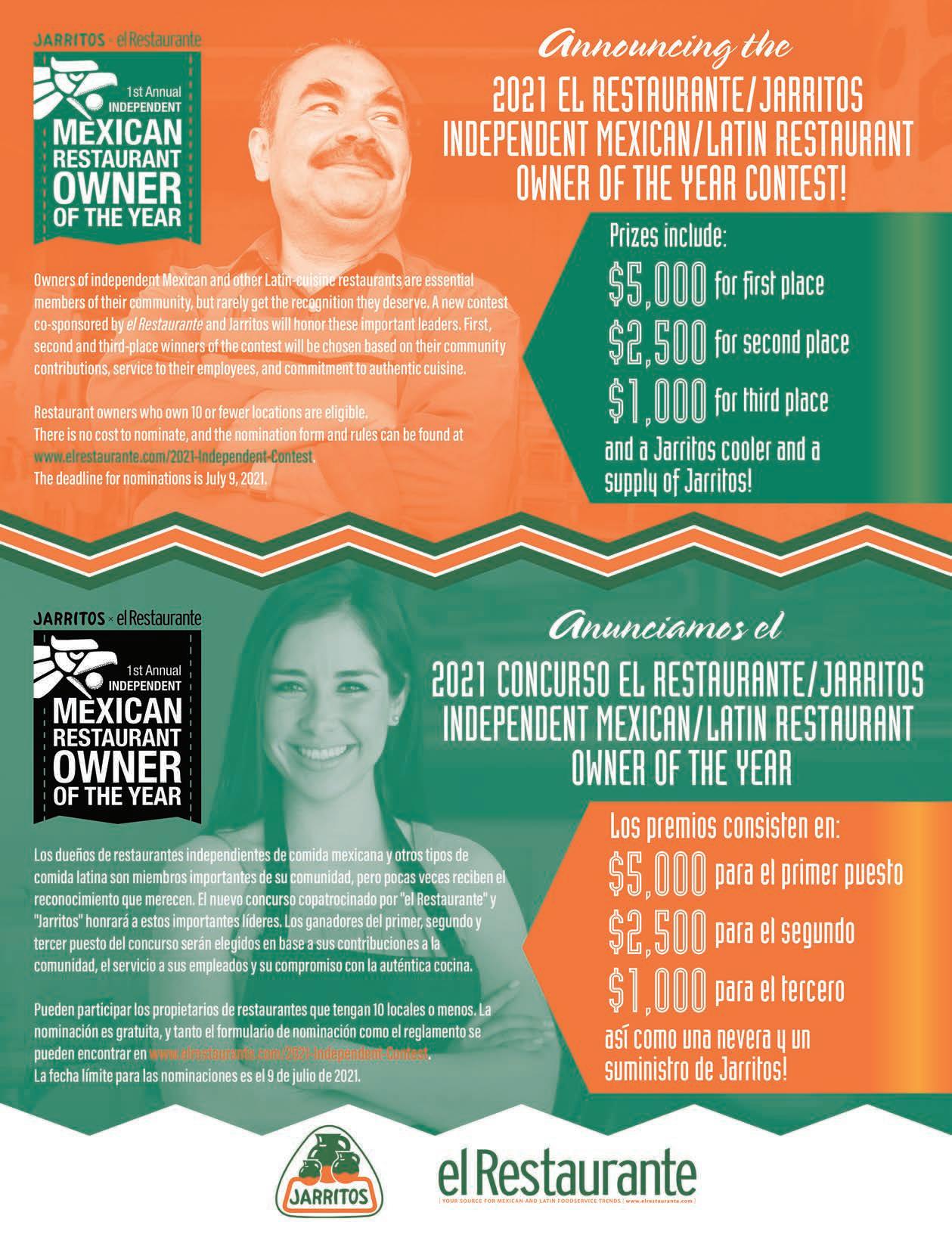
19 minute read
COVER STORY—The Appeal of Asado
asado THE APPEAL OF
Chefs embrace the theater and flavor wood-fired cooking imparts
| BY JACQUELINE RAPOSO | With a recent focus on all things safety, it can be hard to remember the thrill of interactive hospitality.
“Every cooking method has its place, and all can be enjoyable,” says Greg Denton, co-chef-owner with his wife, Gabrielle Quiñónez Denton, of the Argentinian-inspired Ox restaurant in Portland, Oregon. During the COVID-19 pandemic, the Dentons have offered everything from outdoor dining to to-go barbecue boxes. But diners miss out on the theater of their wood-fired grill. “Everyone loves the look and feel of the fire as they enter our restaurant,” Denton continues. “It’s exciting in the same way that a roller coaster is—so much fun, but with a hint of danger.”
While asado has a beloved history among Mexican and Latino cuisines, cooking over wood fire fell out of fashion in U.S. kitchens when cleaner fuels inspired compact setups and faster lines. But as diners pine for the thrill of shared experiences once again, supermarket and chef trends suggest a return to grilling with a heavy interest in spiced meats.
Which means it’s time to bring the fire back where it belongs: everywhere.
A LITTLE ABOUT A LONG HISTORY
Scientists estimate homo sapiens first threw meat onto flames around 1.8 million years ago, and they credit this revelation for why we evolved as we did: cooked foods are easier to digest than raw foods and create surplus energy. Over time, this helped our brains become almost double in size to those of our primate cousins. As our societal bonds deepened, the hunting and gathering of food evolved into gathering around fire to cook and eat it, too.
In following centuries, roaming tribes made and remade spit-roasts for meat and clay ovens for fish. Staid farmers and fishers smoked proteins and baked grains in crude closed “fire chambers.” Then came indoor cooking hearths so tall you could stand in them. In the mid-16th century, Argentina’s gauchos dotted the plains with openfire grills, cooking large slabs of meat on makeshift parillas to define asado cooking. Styles in Brazil, Uruguay, Peru, and Mexico followed.
By the mid-1700s, professional kitchens in the United States swapped out those massive cooking hearths for enclosed “fireboxes” built into chimneyed walls where, for the first time, cooks could somewhat control the heat as it twisted to a series of cooking chambers. The iron boom of the early 1800s then inspired massive cast iron cooking stoves complete with ranges, ovens, broilers, and hoods. Ovens were still fueled by wood until coal became the post-Civil War norm, and the 20th century brought gas and then electricity into the slim, colorful ranges that soon entirely replaced those iron klunkers.
The sole means of cooking for millions of years, open-fire cooking became almost obsolete within a century. It’s still beloved for backyard cookouts and barbecue restaurants. But as anyone working the smoker can tell you, cooking with wood takes work.
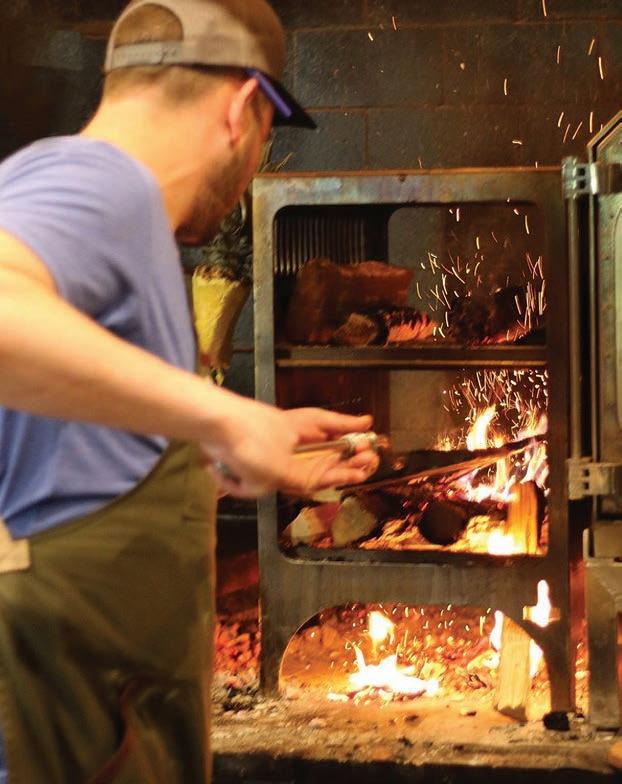
The wood-fired oven at La Vecina Restaurante
AND YET… WE ALWAYS RETURN TO THE HEARTH
“This is how we all started to cook,” says chef Justin Bazdarich of Oxomoco, a Mexican restaurant in Brooklyn, New York. “It’s sort of in “EVERYONE LOVES THE LOOK AND FEEL OF THE FIRE AS THEY ENTER OUR RESTAURANT,” DENTON CONTINUES. “IT’S EXCITING IN THE SAME WAY THAT A ROLLER COASTER IS—SO MUCH FUN, BUT WITH A HINT OF DANGER.”
–CO-CHEF-OWNER GREG DENTON,
Ox restaurant
–CO-CHEF-OWNER GREG DENTON, Ox restaurant
our DNA to be enjoying this in its primality.” Because of its history, it’s almost sacrilegious to call openfire cooking a trend. But as diners seek restaurants that comfort and entertain, chefs lean into cuisines that fire them up, too. Literally.
Coralville, Iowa’s new La Vecina Restaurante creates wood-fired Oaxacan fare, featuring grilled proteins folded into heirloom masa tortillas. For over five years now, Chris and Idie Hastings have relied on open-fire cooking to marry southern ingredients with the cooking traditions of Spain, Portugal, Argentina, and Uruguay at their Birmingham, Alabama Ovenbird. After selling one of his two Mexico Clasico Grill locations in Rockford, Illinois, Chef Jose Chaves renamed his sole location El Fuego Grill to make sure guests know he has a
Family owned and operated for almost 50 years! The Rovey brand has been a trusted source of non-gmo and organic food grade grains and ingredients. *non-gmo & organic white, yellow, blue, red and other food grade grains.

WWW.ROVEYSEED.COM • (217) 227-4541 WWW.ROVEYSEED.COM • (217) 227-4541

Cilantro and green onion add flavor to Oxomoco’s Brazino, as Sasso Chicken hangs
in the background PHOTO BY LOUISE CECILIA PALMBERG
particularly hot offering. And the Dentons’ Argentinian cuisine would not be complete without it: “We knew our first restaurant would feature wood-fire cooking because we love the smoky, charred flavors that this kind of grilling imparts,” Denton says assuredly.
Bazdarich got hooked on wood-fired cooking at his first restaurant, too. “I wanted everything to be wood-fired,” he remembers of the first dishes coming out of his wood-burning ovens at Speedy Romeo in Manhattan. “I wanted wood-fired tacos, wood-fired steak frites…” Having traveled throughout Mexico since high school, he points out that ingredients like chiles and masa already have or pair well with inherently earthy, smoky flavors. It only made sense to give two wood-burning grills focus at Oxomoco, too. “I took all my favorite dishes and put a wood-fired twist to them,” he says of that menu.
THE CHALLENGES
Of course, folding wood-fire cooking into a professional kitchen isn’t as simple as firing up a Weber or Big Green Egg.
For decades, even the toughest commercial grills came with expensive upkeep and lacked finesse. Then designers like Ben Eisen-
– CHEF JUSTIN BAZDARICH, Oxomoco

drath hit the scene. Eisendrath’s Grillworks grills replicate the asado technique with angled grates, rotisseries, mesh surfaces, and planchas that move by crank wheels over adjustable fireboxes so that chefs get the precise steam or char they desire. They’re dubbed the “gold standard of wood-burning grills” by The New York Times, and the Dentons are among those who praise their custom-made setups. La Vecina’s stacked setup comes from Grills by Demant, an Atlanta-based company that customizes stainless-steel grills for regional chefs. Texas companies Champion Tuff Grills and M Grills also make grills that handle that heat. Such getups make for expensive startup costs but are worth the long-term investment.
Sourcing natural, kiln-dried hardwood for those grills isn’t an issue. But wood isn’t the friendliest fuel to cook with. “The biggest challenge is the physical nature of it,” says Denton, whose chefs continually load and unload heavy fuel, and regularly risk dehydration and heat rashes from standing for hours at the fire.
Bazdarich points out that wood is more expensive to purchase and store than gas or electricity, too, and that unlike those other fuels, it’s an ingredient: “It also adds flavor to the dish,” he says. While he’s never figured wood into his menu costs, he points out the expense should be reflected there.
There are expenditures related to state environmental regulations, too. New York City now requires a “smog hog” to mist smoke particulates out of exhaust systems before it clears the roof.
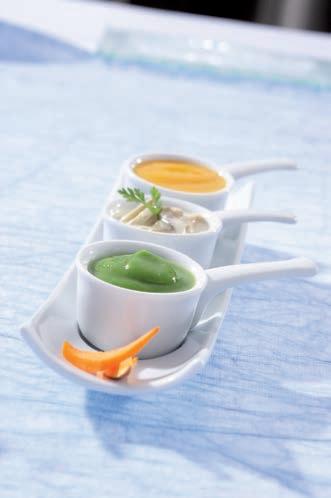
Ovenbird’s Paella on the Patio



Soups, sauces and salsa ! Immersion Blenders
#1 Selling
20 models available :
· Removable stainless steel blade and bell for perfect sanitation · Multipurpose : blade and whisk · Powerful motor for great performance · Compact and easy to handle appliance · Patented Easy Plug system making it far easier to replace the power cord for MP
Models during after-sales servicing
Book a free demonstration in your kitchen on www.robot-coupe.com Robot-Coupe USA., Inc., info@robotcoupeusa.com
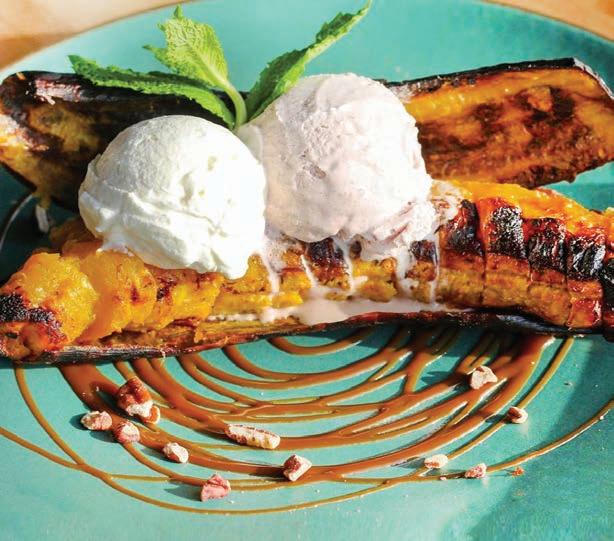
La Vecina Restaurante’s wood oven-roasted Plátanos In Portland, Oregon, a woodfired hearth requires a separate hood system entirely. These are costly to build out, clean, and maintain. “I understand it. But the expense is exhausting,” Bazdarich says.
THE REWARDS
Even with all those things considered, wood-fire cooking transforms ingredients so fully as it cooks, crisps, and caramelizes that there’s no substitute for it.
“There are very few things that are not fitting for the wood fire,” Denton says of its versatility, citing how tender fish fillets, tiny spring onions, and sweet seasonal melons all benefit. The collagen of skin and bones in whole animals and large chops meld to turn out incredibly tender and juicy results, too, cutting down ingredient waste at the same time. “It can bring a concentration of flavor that other cooking methods may not be able to,” he points out.
Bazdarich incorporates the grill into most dish components at Oxomoco, even grilling ingredients before chilling them for marinades and salsas. But his Sasso
neHUB
COLLECTION






VEGETABLE CUTTER JERKY SLICER





STUNNING DESIGN FOR ANY KITCHEN
MEAT GRINDER
ONE MOTOR MULTIPLE ATTACHMENTS
MEAT CUTTER
MEAT TENDERIZER
SAVE LABOR COSTS INCREASE PROFITS
Chicken—which he brines and cooks in a low oven before hanging over the grill to slow smoke and then fries to finish—wouldn’t be the same without it. “We wouldn’t be able to get that same level of smoke flavor that’s so subtle and nice and juicy and tender,” he says of how other barbecue methods would overpower the particular hen’s subtle, tender fat and flavor. Even meatless, tortillabased dishes like his Spring Pea Tlayuda with salsa cruda, mint puree, quesillo, serrano and scallions get the wood-fire treatment.
While an incredibly versatile a cooking method, eaters know dining by an open fire remains a rarity, and noses perk wherever sweet smoke wafts. As food only gets tastier when touched by flame, asado is an antique technique that well deserves trending.
Ready to take the torch?
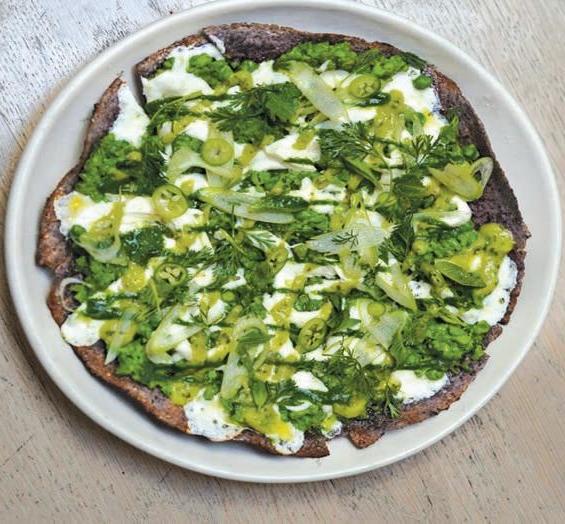
Jacqueline Raposo is a food writer and podcast producer based in New York City. First generation Azorean American, her mouth waters for fresh fish grilled over open flames and playing fútbol with family 0while waiting on churrasco.
See recipe for Oxomoco’s wood-fired roasted Spring Pea Tlayuda on page 54.
Oxomoco’s Spring Pea Tlayuda
– CHEF JUSTIN BAZDARICH, Oxomoco

asado EL ATRACTIVO DEL
Los chefs apuestan por el teatro y el sabor que proporciona la cocina de leña
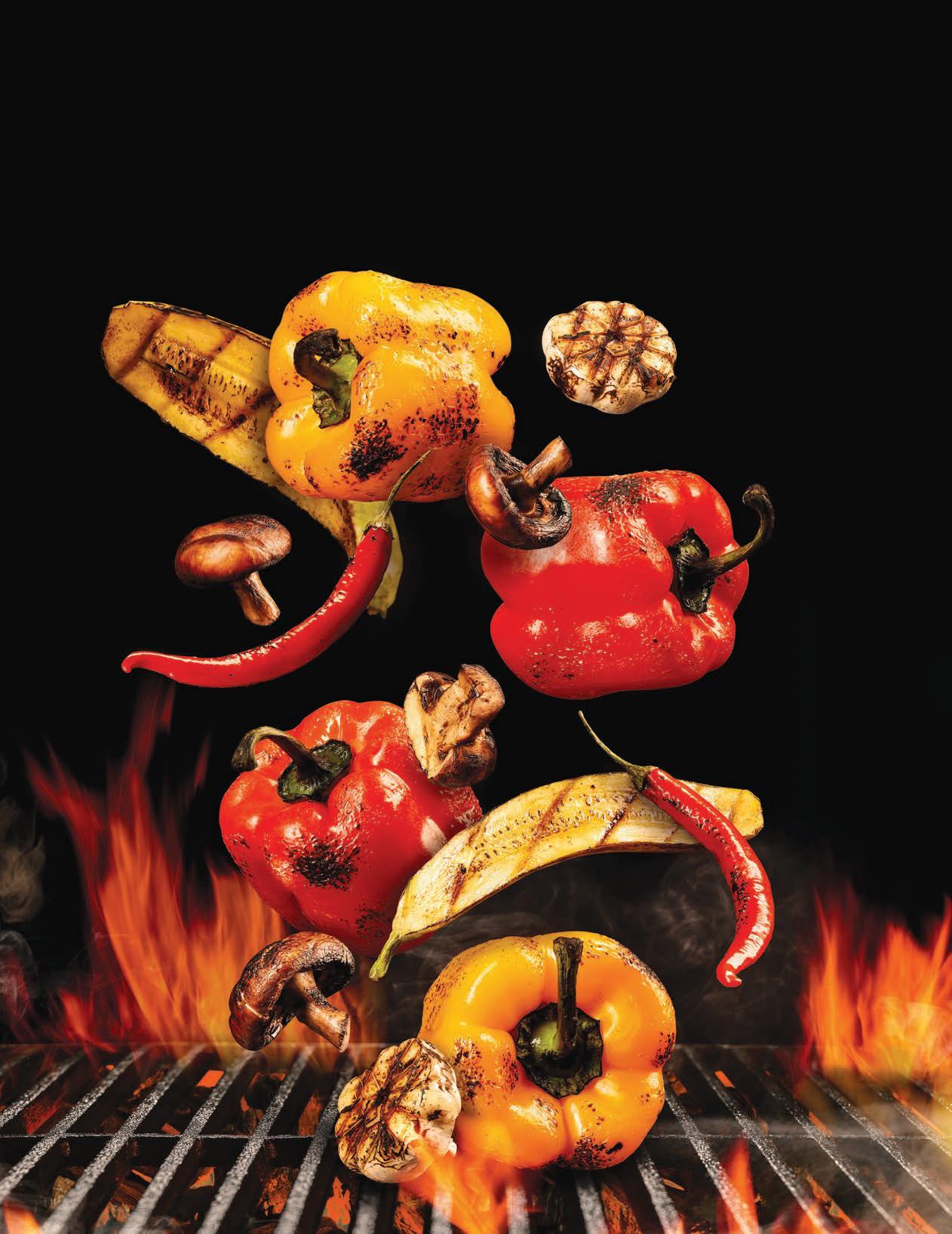
| POR JACQUELINE RAPOSO | Con el énfasis actual en todo lo relacionado con la seguridad, puede ser difícil recordar la emoción de la hospitalidad interactiva.
“Cada método de cocina tiene su lugar, y todos pueden ser agradables”, dice Greg Denton, copropietario con su esposa, Gabrielle Quiñónez Denton, del restaurante Ox, de inspiración argentina, en Portland, Oregón. Durante la pandemia de Covid-19, los Denton han ofrecido desde cenas al aire libre hasta cajas de barbacoa para llevar. Pero los comensales se pierden el teatro de su parrilla de leña. “A todo el mundo le encanta el aspecto y la sensación del fuego al entrar en nuestro restaurante”, continúa Denton. “Es emocionante, igual que lo es una montaña rusa: muy divertido, pero con una pizca de peligro”.
Aunque el asado tiene una historia muy querida entre las cocinas mexicana y latina, cocinar con fuego de leña pasó de moda en las cocinas estadounidenses, cuando los combustibles más limpios inspiraron montajes compactos y mayor rapidez en las filas. Pero a medida que los comensales vuelven a anhelar la emoción de las experiencias compartidas, las tendencias de los supermercados y de los chefs sugieren una vuelta a la parrilla, con un gran interés por las carnes especiadas.
Lo que significa que ha llegado el momento de devolver el fuego a donde debe estar: en todas partes.
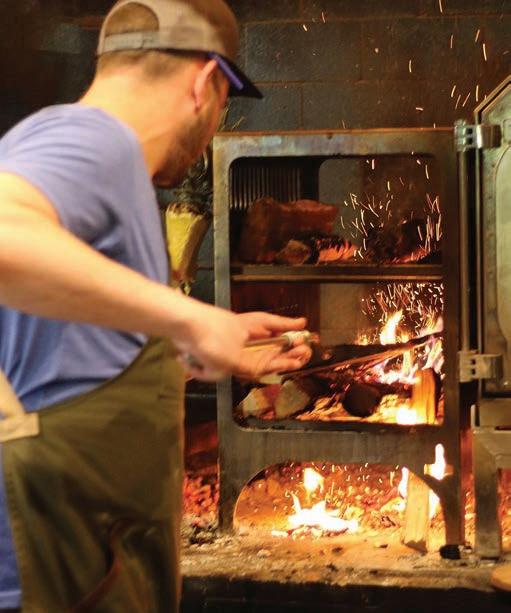
UN POCO SOBRE UNA LARGA HISTORIA
Los científicos estiman que el homo sapiens echó por primera vez carne al fuego hace unos 1.8 millones de años, y atribuyen a esta revelación la razón por la que evolucionamos como lo hicimos: los alimentos cocinados son más fáciles de digerir que los crudos y crean un excedente de energía. Con el tiempo, esto ayudó a que nuestros cerebros tuvieran casi el doble de tamaño que los de nuestros primos primates. A medida que nuestros lazos sociales se profundizaban, la caza y la recolección de alimentos evolucionaron hacia la reunión en torno al fuego para cocinarlos y también para comerlos.
En los siglos siguientes, las tribus itinerantes hicieron y rehicieron asadores para la carne y hornos de barro para el pescado. Los agricultores y pescadores sedentarios ahumaban las proteínas y horneaban los granos en toscas “cámaras de fuego” cerradas. Luego llegaron los fogones interiores, tan altos que se podía estar de pie en ellos. A mediados del siglo XVI, los gauchos argentinos salpicaron las llanuras con parrillas de fuego abierto, cocinando grandes trozos de carne en parillas improvisadas para definir la cocina del asado. Le siguieron estilos en Brasil, Uruguay, Perú y México.
A mediados del siglo XVII, las cocinas profesionales de Estados Unidos cambiaron esos enormes fogones por “cajas de fuego” cerradas construidas en paredes con chimeneas en las que, por primera vez, los cocineros podían controlar en cierto modo el calor al girar hacia una serie de cámaras de cocción. El auge del hierro a principios del siglo XIX inspiró entonces las enormes cocinas de hierro fundido completas con fogones, hornos, parrillas y campanas. Todavía con leña como combustible, hasta que el carbón se impuso después de la Guerra Civil, el siglo XX trajo el gas y luego la electricidad a las esbeltas y coloridas cocinas que pronto sustituyeron por completo a esos aparatos de hierro.
El horno en La Vecina Restaurante
– GREG DENTON, chef copropietario del restaurante Ox
– GREG DENTON, chef copropietario del restaurante Ox

Paella de Ovenbird
Como única manera de cocinar durante millones de años, la cocina de fuego abierto quedó casi obsoleta en un siglo. Sigue siendo muy apreciada en las comidas al aire libre en los patios y en los restaurantes de barbacoa. Pero como puede contarle cualquiera que trabaje con un ahumador, cocinar con leña implica mucho trabajo.
Y SIN EMBARGO... SIEMPRE VOLVEMOS A LOS FOGONES
“Así es como todos empezamos a cocinar”, dice el chef Justin Bazdarich de Oxomoco, un restaurante mexicano de Brooklyn, Nueva York. “Está en cierto modo en nuestro ADN disfrutar de esto en estado puro”. Debido a su historia, es casi un sacrilegio decir que la cocina a fuego abierto es una moda. Pero a medida que los comensales buscan restaurantes que los reconforten y entretengan, los chefs se inclinan por cocinas que también los enciendan. Literalmente.
El nuevo restaurante La Vecina de Coralville, Iowa, crea comida oaxaqueña a la leña, con proteínas a la parrilla dobladas en tortillas de masa tradicionales. Desde hace más de cinco años, Chris e Idie Hastings confían en la cocina a fuego abierto para combinar los ingredientes sureños con las tradiciones culinarias de España, Portugal, Argentina y Uruguay en su local de Birfavoritos y les di un toque de leña”, dice sobre ese menú.
Brazino y pollo de Oxomoco mingham, Alabama, Ovenbird. Después de vender uno de sus dos locales de México Clásico Grill en Rockford, Illinois, el chef José Chaves rebautizó su único local con el nombre de El Fuego Grill para que los comensales sepan que tiene una oferta especialmente ardiente. Y la cocina argentina de los Denton no estaría completa sin ella: “Sabíamos que nuestro primer restaurante contaría con cocina de leña porque nos encantan los sabores ahumados y carbonizados que ofrece este tipo de parrilla”, dice Denton con seguridad.
Bazdarich también quedó fascinado por la cocina de leña en su primer restaurante. “Quería que todo fuera a la leña”, recuerda de los primeros platos que salían de sus hornos de leña en el Speedy Romeo de Manhattan. “Quería tacos a la leña, bistecs fritos a la leña...” Al haber viajado por todo México desde el instituto, señala que ingredientes como los chiles y la masa ya tienen o combinan bien con sabores inherentemente terrosos y ahumados. Era lógico que en Oxomoco también se centraran en dos parrillas de leña. “Agarré todos mis platos

LOS DESAFÍOS
Por supuesto, incorporar la cocina de leña a una cocina profesional no es tan sencillo como encender una Weber o un Big Green Egg.
Durante décadas, incluso las parrillas comerciales más resistentes tenían un mantenimiento costoso y carecían de delicadeza alguna. Entonces entraron en escena diseñadores como Ben Eisendrath. Las parrillas Grillworks de Eisendrath reproducen la técnica del asado con rejillas angulares, asadores, superficies de malla y planchas que se mueven mediante ruedas con manivela sobre las cajas de fuego ajustables para que los chefs logren el vapor o el carbonizado preciso que desean. El New York Times las ha calificado como el “patrón a seguir de las parrillas de leña”, y los Denton están entre los que alaban sus montajes a medida. La configuración apilada de La Vecina proviene de Grills by Demant, una empresa con sede en Atlanta que personaliza parrillas de acero inoxidable para los chefs de

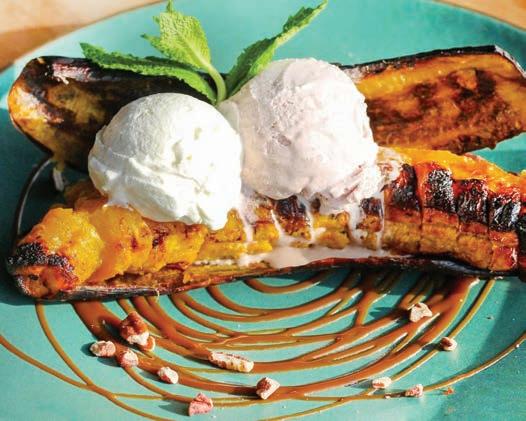
Plátanos de La Vecina Restaurante
la región. Las empresas de Texas Champion Tuff Grills y M Grills también fabrican parrillas que soportan ese calor. Estas parrillas suponen unos costos iniciales elevados, pero la inversión a largo plazo merece la pena.
Conseguir madera dura natural y secada al horno para esas parrillas no es un problema. Pero la madera no es el combustible más agradable para cocinar. “El mayor reto es su naturaleza física”, dice Denton, cuyos cocineros cargan y descargan continuamente el pesado combustible, y se arriesgan con frecuencia a sufrir deshidratación y erupciones cutáneas por estar de pie durante horas junto al fuego.
Bazdarich señala que la madera es más cara de comprar y almacenar que el gas o la electricidad, también, y que a diferencia de esos otros combustibles, es un ingrediente: “También añade sabor al plato”, dice. Aunque nunca ha incluido la madera en los costos de su menú, señala que el gasto debería reflejarse ahí.
También hay gastos relacionados con la normativa medioambiental estatal. La ciudad de Nueva York ahora exige un “filtro de aire” para nebulizar las partículas de humo de los sistemas de escape antes de que lleguen al techo. En Portland (Oregón), una chimenea de leña requiere un sistema de campana totalmente independiente. Estos son costosos de construir, limpiar y mantener. “Lo entiendo. Pero el gasto es desorbitado”, dice Bazdarich.

LAS RECOMPENSAS
Incluso teniendo en cuenta todas esas cosas, la cocina de leña transforma los ingredientes por completo a medida que los cocina, los vuelve crujientes y los carameliza, de modo que no hay nada que la sustituya.
“Hay muy pocas cosas que no sean adecuadas para el fuego de leña”, dice Denton sobre su versatilidad, y menciona cómo se benefician de ella los tiernos lomos de pescado, las diminutas cebollas cambray y los dulces melones de temporada. El colágeno de la piel y los huesos de los animales enteros y las chuletas grandes se funden para obtener resultados increíblemente tiernos y jugosos, reduciendo al mismo tiempo el desperdicio de ingredientes. “Puede aportar una concentración de sabor imposible de conseguir con otros métodos de cocina”, señala.
Bazdarich incorpora la parrilla a la mayoría de los componentes de los platos en Oxomoco, incluso asando los ingredientes antes de enfriarlos para los escabeches y las salsas. Pero su Pollo Sasso—que pone en salmuera y cocina en un horno a baja temperatura antes de colgarlo sobre la parrilla para ahumarlo lentamente y freírlo para terminar—no sería lo mismo sin ella. “No podríamos conseguir ese mismo nivel de sabor ahumado que es tan sutil, agradable, jugoso y tierno”, dice sobre cómo otros métodos de barbacoa dominarían la grasa y el sabor sutil y tierno de la gallina en particular.
Aunque se trata de un método de cocción increíblemente versátil, los comensales saben que cenar junto a un fuego abierto sigue siendo algo poco frecuente, y los olfatos se agudizan allí donde el humo dulce se difunde. Como la comida solo se vuelve más sabrosa al contacto con la llama, el asado es una técnica antigua que bien merece estar de moda. ¿Listos para tomar el relevo?
– JUSTIN BAZDARICH, chef de Oxomoco
Jacqueline Raposo es una escritora gastronómica y productora de podcasts afincada en la ciudad de Nueva York. Americana de primera generación de las Azores, se le hace la boca agua con el pescado fresco asado al fuego y jugando al fútbol con la familia mientras espera el churrasco.
Spring Pea Tlayuda de Oxomoco; ver receta en la página 54
